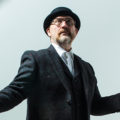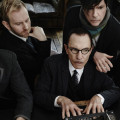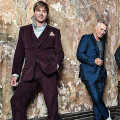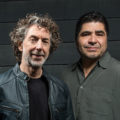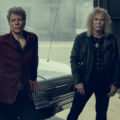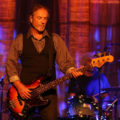The Church’s “Starfish” observes 30 years “Under The Milky Way” with complete album concert
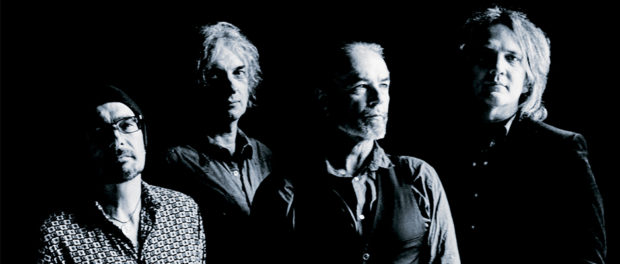 Photos provided by The Church
Photos provided by The Church
Put The Church’s “Starfish” album on right now, and outside of the occasional production flourish or possibly benefitting from a digital remaster, the lean, driving and periodically dreamy collection doesn’t sound even remotely 30 years old. While the ten tracks could’ve easily come out in today’s alternative/indie rock landscape, they were indeed a product of 1988 and earned mounds of worldwide attention for the Australian act thanks to mega-singles “Under The Milky Way” and “Reptile,” a pair of “Miami Vice” soundtrack slots (plus tons more to come) and gold-selling status.
Although The Church is performing the entire album in concert on October 17 at Lincoln Hall to mark the special occasion, the group now comprised of original singer/songwriter/bassist Steve Kilbey, co-founding guitarist Peter Koppes, longtime drummer Tim Powles, new-ish guitar recruit Ian Haug (of Powderfinger fame), along with fellow axe man Jeffrey Cain (ex-Remy Zero, Kilbey’s Isidore collaborator) is by no means one to reminisce. In fact, 2017’s “Man Woman Life Death Infinity” marks its 26th release with lots more coming around the corner according to Koppes, who waxed a little nostalgia with Chicago Concert Reviews in hopes it will steer casual listeners towards the band’s recent whereabouts.
 “Starfish” is amongst the most regarded albums of its era and continues to get discovered today. What do you think are the qualities that contribute to its longevity?
“Starfish” is amongst the most regarded albums of its era and continues to get discovered today. What do you think are the qualities that contribute to its longevity?
Peter Koppes: Obviously a hit single like “Under The Milky Way” drew a lot of attention to this album, but interestingly, that song received little priority by us during the recording sessions and was not even rehearsed beforehand being an acoustic guitar backing track. We were more interested in the rest of the album, which was a consolidation of our band songwriting that had been very satisfying on the previous “Heyday” album, despite us being dropped afterward by our previous USA and Australian labels.
Can you give us the story behind “Under The Milky Way” and a look at how its legend continues to grow?
Koppes: The song was irreverently regarded as a novelty and relegated to an in-house music specialist engineer to create a backing track on the new, very expensive Synclavier sequencer keyboard computer. He even used backward samples of Irish bagpipes, which we all found very amusing. But the incredibly eminent record company head Clive Davis identified it as a hit single and so we allowed them to release it to protect their $500,000 investment in the album. Its longevity is like a snow ball that has increased in size by rolling along, collecting more and more associations for people and being used in events as a soundtrack, but essentially it has a common thread for most people by its melancholic, philosophical yearning for the romantic and other things…without being wet or specific maybe.
Though The Church has a fiercely loyal fan base all over the world of many who’ve kept up with all of your albums, do you ever wish more casual listeners in America would dive deeper into your catalogue or do you prefer a closer knit community with those in the know?
Koppes: I am sure it is not our fault that more people are not aware of the soulful nurturing that our music achieves for those that are familiar and makes The Church their favourite band of all, except the legends maybe. But the general public has quite shallow tastes that are easily manipulated by strong rhythm and sensationalism so I do not expect more from them. We are a musicians’ band and there is no greater satisfaction that the approval of your peers, such as the accolade of being invited by [The Cure’s] Robert Smith to appear at the Meltdown Festival in London that he curated this year.
 The group is not typically known for looking back to the past too often, instead frequently forging forward with new material. Outside of the obvious anniversary angle, what prompted you to go back to the “Starfish” period?
The group is not typically known for looking back to the past too often, instead frequently forging forward with new material. Outside of the obvious anniversary angle, what prompted you to go back to the “Starfish” period?
Koppes: It is a joyous occasion to recreate those songs to a very appreciative expanded audience who probably suspect new material would be as bad as that delivered by the old legends, who these days foist upon their fans very diluted examples of their legacy.
Nowadays, The Church has a mixture of original members and famous faces from other acts. How has that combination contributed to fresh interpretations of your older material?
Koppes: We are very thankful for the rejuvenation that Ian Haug has contributed with his sympathetic talent and confidence from being from the biggest Australian band in history. Tim Powles has been the drummer 25 years, but his contribution as an innovative creative co-producer really became evident with “Hologram Of Baal” and the post-production/mixing we shared. But they respect immensely the musicians that preceded them and try to recreate it exactly.
Is there anything you noticed about the album now that you’re preparing to perform it that you might not have realized since the recording sessions?
Koppes: The first thing we noticed is that the songs required very few additional tracks or overdubs to enhance them. We are usually known for elaborate orchestrations of albums, but this time the songs were very concise. Maybe a distillation of the band/solo songwriting process had occurred because it certainly has a conciseness of musical ideas.
What else do you have planned for the performance in Chicago?
Koppes: This year is also the anniversary of “Hologram Of Baal” 20 years ago. [That album] represented a new direction for the band, which has afforded a place for the band firmly in the new Millennium, and not so humbly, I would say we have very little company. We played highlights from the album at our recent London convention after the Meltdown Festival and we are very excited to share their refreshing sounds again.

How would you describe your relationship with our city?
Koppes: We have a very artistic and culturally ambitious capital city in Australia called Melbourne that rivals the fame of the beautiful Sydney and Chicago always made me think of the same comparison to New York.
Do you remember where you played in town on the original tour back in 1988 and anything specific about the show?
Koppes: The USA is such a huge place that tours become blurred, but I do remember a beautiful old theatre we played with Echo & The Bunnymen before the “Starfish” album came out. I also remember the big ex-strip club we often play these days where we once had the house record for the most merchandise sales!
What do you hope listeners take away from the entire 2018 “Starfish” experience?
Koppes: I hope they realise that our new songs are just as intoxicating as the “Starfish” album and realise they can be inspired again having faith that music evolution is not dead.
Can you give us a sneak preview of what to expect next from the band in the studio and beyond?
Koppes: It will always be adventurous and unpredictable. Please listen to our last two albums for proof.
The Church performs at Lincoln Hall on Oct. 17. For additional details, visit TheChurchBand.net, JamUSA.com and LH-ST.com.


